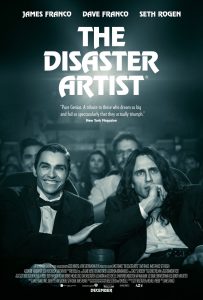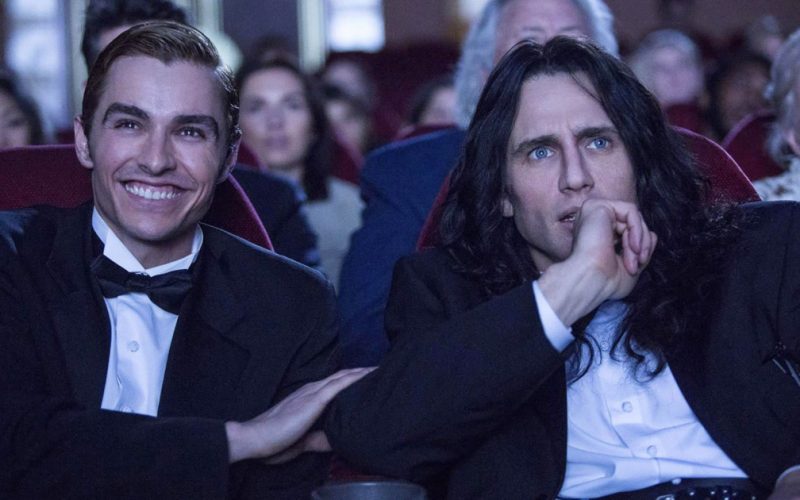The Disaster Artist (2017) – Review.
 The Disaster Artist is a film that’s unapologetically in awe of its tale and its star. In a relatively straight-forward narrative, James Franco explores the mystery of Tommy Wiseau and the problematic creation of his cult classic film The Room. Revered for how terrible it is, and the worthiest film to ever claim the title of “so bad it’s good,” how The Room came about was apparently worthy of exploring for Franco and his cohorts. The result is many different things, but dull is the last word that springs to mind.
The Disaster Artist is a film that’s unapologetically in awe of its tale and its star. In a relatively straight-forward narrative, James Franco explores the mystery of Tommy Wiseau and the problematic creation of his cult classic film The Room. Revered for how terrible it is, and the worthiest film to ever claim the title of “so bad it’s good,” how The Room came about was apparently worthy of exploring for Franco and his cohorts. The result is many different things, but dull is the last word that springs to mind.
In actuality, this is a damn fine film, and joyously hysterical in the kind of way that glues you to the screen mostly in bewilderment. Events unfold with a certain energy and there’s clear and total devotion to bringing this how-to (and how-not-to) tale of making a film to life. James Franco puts forward perhaps his best ever performance, completely losing himself to the mystery that is Tommy Wiseau and giving one of the most accurate big screen depictions of a real life person ever. Dave Franco plays Greg, who is as close to an everyman as we’re going to get here.
The admiration for how this film came about doesn’t stop The Disaster Artist from engaging in mockery. It’s prepared to poke fun and keep Tommy at arm’s length, falling short of letting him in on the joke. The film is sprinkled with sequences that range from hilarious to discomforting. Tommy Wiseau is at the centre of the film, but I’m not sure that it makes sense to call him the protagonist; we hardly know anything about him by default, and it’s only on a scarce few occasions that we sympathize for him. Certainly, completing The Room and reaching fame is the goal here, though Tommy is as much an obstacle as he is the instigator of such an ambitious project. His (kind of) best friend, Greg, is a dreamer, and his naivety gets him in too deep with Tommy before he finally stops seeing him through rose-tinted glasses. Greg’s story is more engaging on an emotional level. He sees what we see, and his relationship with those around him and with the film itself provides the core of the narrative. It’s all well and good to throw jabs and remarks that are equal parts baffling and rousing, but without Greg this film would be a mostly tasteless and disengaging one.
The film has very few characters. Those that are there mostly offer us different angles from which we get to evaluate Tommy. Seth Rogen, Alison Brie, and Josh Hutcherson all play notable supporting roles and there’s a brilliant cameo from Bryan Cranston that winks at his 90’s, pre-Breaking Bad life. Some of Tommy’s film crew tease us a little about what might be under the hood, and contemplate the true motivation behind the events written into Wiseau’s script. But nothing is made concrete. He’s something of an enigma, and so the film must hinge its dramatic prowess on his relationship with Greg and, to a much greater extent, The Room itself. The first half of the film builds to the crucial decision, motivated by Greg, following shortly after Tommy’s lowest moment. From there, things speed right up. Greg is a victim of the film’s revamped and streamlined driving motive. Integral though he may be to the film, his character does a complete circle by the end of the film in order to service a rather upbeat and triumphant climax.
The first half of the film is genuinely committed to Tommy’s ill-fated attempt at stardom and his desire to be the hero and not the villain is tragic in all the right ways. We might pity him during these early stages, though that washes away when we see how he treats those around him. When he compares his treatment of his crew to how masters of cinema such as Hitchcock and Kubrick treated theirs, we’re asked to bury ourselves in the ridiculousness of this man’s vision. By this point, we’re in neck-deep. There’s a kind of harmlessness to Tommy. Despite how his actions might seem, they’re only ever motivated by a desire to achieve something great. His aggression is a direct result of his lack of self-esteem and belief despite his quasi-fearlessness. That’s not to justify his awful behaviour, only that it’s commendable what Franco is able to do with the role.
In the film’s climax, we watch as an audience sits in at the premiere, preluded by Tommy’s “grand” entrance. At first, it’s an unpleasant experience. No one really knows how to react. It’s awkward and it’s cringeworthy. It might be how a filmgoer treats The Disaster Artist if he or she doesn’t quite know what they’re in for. By the end of The Room, the crowd is roaring with laughter. They embrace the silliness and so do we. The Disaster Artist will be considered a monumentally better film than The Room yet it’s unlikely to earn the same kind of prestige. I expect that the two films will make a great double feature, keeping The Room running in theaters for a long time yet.
Film ’89 Verdict – 8/10
The Disaster Artist is on general release in the U.K. and US now.

